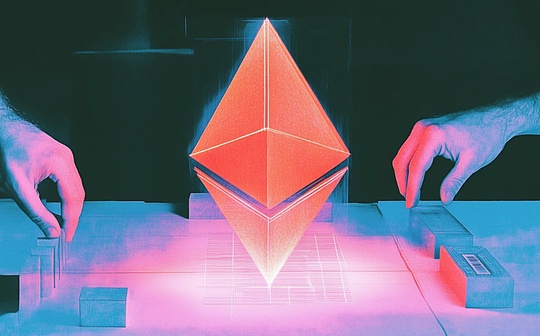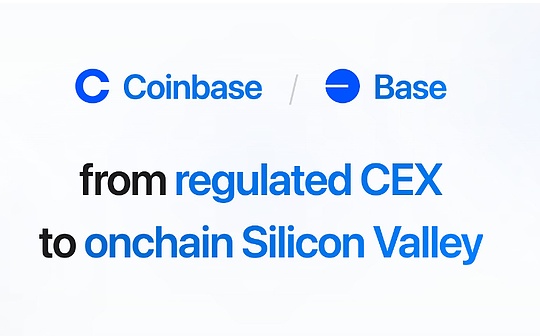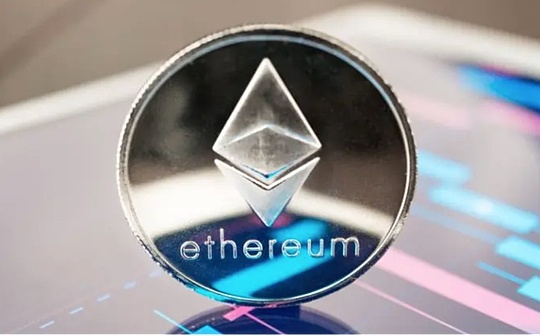
Source: IOSG Ventures
background
Two years ago, at the beginning of the rise of modular blockchain narratives, we wrote an article to propose our views and predictions on the Data Availability track.As we expected, the narrative of modular blockchain has prevailed and promoted infrastructure innovation, enhanced network interoperability, and promoted more collaboration and integration within the ecosystem, with various Rollup as a service(RaaS) solutions (Altlayer, Caldera, Conduit, Gelato) are beginning to emerge.The following figure shows the interface of the Rollup development tool Conduit, which shows that deploying Rollup and selecting DA solutions has become extremely simple and convenient.
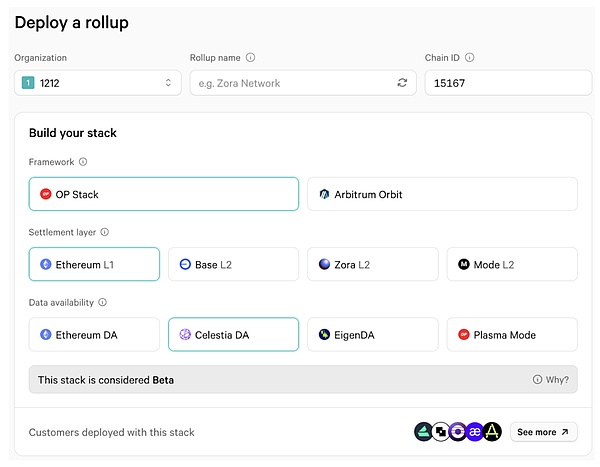 Source: Conduit
Source: Conduit
Alternative DA solutions (Alt-DA) such as Celestia, EigenDA, Avail, NearDA have made significant progress in the past two years, each showing unique technological advantages and market share.At the same time, with the launch of Ethereum EIP-4844, the introduction of blobs to replace calldata has greatly reduced the cost of using Rollup in the Ethereum native DA layer.Nowadays, developers and project parties face more trade-offs when choosing data availability layer. This article will track and analyze existing DA solutions, deeply explore their performance costs, technical characteristics and market performance, and propose our future DA trackDevelopment perspectives and thoughts.
1. Adoption of existing DA solutions
Rollup using Ethereum native DA on-chain solutions focuses on mainstream Layer 2 solutions that have been updated from calldata storage to adapt to blobs, including Arbitrum, Optimism, and Base, as well as Starknet, zkSync, and Scroll.By using Ethereum as the DA layer, Rollup will be verified and stored by Ethereum’s full nodes, benefiting from Ethereum’s security, degree of decentralization, continuity of protocol upgrades and economic incentive mechanisms.Comprehensive L2 occupies an important position in the Ethereum ecosystem, and it is necessary to use the above orthodoxy brought by native DA as the core difference.(Vitalik believes that the core of rollup is unconditional security guarantee: even if everyone is enemies of you, you can take out your assets. If data availability depends on external systems, you cannot get this equivalent security)
However, publishing data to the Ethereum mainnet comes with high costs, especially before EIP-4844 (calldata cost 16 gas per byte, and in December 2023 alone, L2 spent more than 15,000 ETH on DA costs).Therefore, a variety of Alt-DA off-chain solutions have emerged, such as Celestia, EigenDA, and Avail, which have not yet been launched. Through different technical means, such as DAS, erasure coding, KZG commitment, etc., data storage and transmission are reduced.cost.
Among them, Celestia, as a modular blockchain dedicated to DA, has become a leading project in the DA track after its main network was launched in October 2023. The main target customers include projects that require a modular architecture: cross-chain bridge, settlementLayer solutions, defi projects, games, sorters, and Layer 2 solutions that are not limited to the Ethereum ecosystem.Its existing customers include Omnichain DEX protocol Orderly, modular L2 Manta Pacific customized for EVM-native ZK applications, L3 Hokum based on Base, and DEX Lyra and Aevo, which focus on derivatives trading.As a pioneer in modular design DA layer that is not limited to a specific ecosystem, Celestia’s advantages make it the first choice for many emerging Layer 2 projects.
EigenDA is developed by EigenLabs. It uses EigenLayer’s restating mechanism to provide efficient, secure and scalable DA service solutions, inheriting the security of the Ethereum main network to a certain extent and a huge validator network.EigenDA focuses on providing high-performance DA solutions to the Ethereum ecosystem.As the first active verification service (AVS) on Eigenlayer, EigenDA was launched with the Eigenlay main network in April. The existing customer base is also diverse, including Ethereum L2 Swell, Celo, Mantle Network, and many built on EigenlayerOther AVS, such as decentralized computing stack Versatus, Polymer, DEX protocol DODO, and CyberConnect as Social L2, etc.
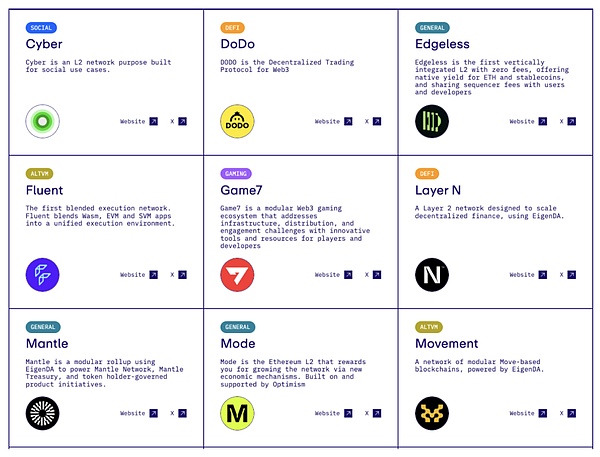
Source: EigenDA
2.Trade-off between native DA (EIP-4844) and existing Alt-DA
2.1 Ethereum native DA
A brief review of the development and changes of Ethereum native DA solutions. Before the Cancun upgrade, Rollup mainly used calldata as a means of data storage and transmission.Due to permanent storage and high network congestion, high fees have become the main obstacle to expansion and adoption.As the main network upgrade, EIP-4844 has introduced a new data structure of Blobs. Blobs can accommodate large-capacity data, but will increase the storage burden of nodes accordingly.Over time, storage requirements will continue to increase, which may eventually lead to excessive hardware requirements for running nodes, thereby injuring decentralization.Therefore, Blobs only need to be stored for about 18 days (4096 epochs) and will be deleted.
Since Blobs only need temporary storage and use a separate fee market, after the implementation of EIP-4844, the average daily DA cost (30 days before and after Scroll & Starknet) was reduced.About 99%.Among them, due to the different types of uploaded data (transaction data or status differences), Layer2 using OP rollup benefits more significantly compared to Zk Rollup’s cost reduction.

Source: Dune& Growthepie
EIP-4844 Blob capacity and storage characteristics and pricing mechanism
Blob capacity and storage features:
-
Each block can accommodate up to 6 blobs
-
Each blob can store up to 128KB of data (the sender will have to pay the full blob fee even if 128KB of space is not fully used)
The new blob gas market, operating in a similar manner to EIP-1559, adjusts the basic blob expenses according to changes in supply and demand:
-
If the number of blobs in the block exceeds the target (currently 3), increase the basic blob fee.
-
If the number of blobs in the block is less than the target, reduce the basic blob expenses.

Source: IOSG Ventures
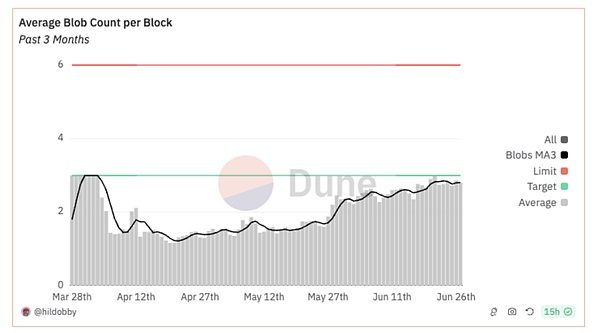
Source: Dune/Ethereum block blobs number 3-day moving average
L2 mainly uses the newly introduced Type 3 transaction, adding max_fee_per_blob_gas and blob_versioned_hashes fields based on previous transactions, representing the maximum fee per blob gas that the user is willing to pay and the hash output list of kzg_to_versioned_hash respectively.
This new pricing mechanism means that type 3 transactions still require max_fee_per_gas and max_priority_fee_per_gas fields and are subject to the existing EIP-1559 market.In addition to the blob space, type 3 transactions still need to pay for the EVM space they use.
Therefore, there is still competition for block space in blobs, causing cost uncertainty, because the blob space in each block is limited, and the gas fee market of blobs is dynamically adjusted according to demand.
Therefore, as a general chain, Ethereum also has the shortcomings of uncertainty in block space – there may be sudden on-chain activities such as NFT Minting and airdrop application, which leads to on-chain congestion, and the pricing of Blobs will be raised, making Rollup unable to estimate the cost basis.This will cause uncertainty in Rollup’s expenditure budget to lead to unstable profit margins, increasing the barriers to the use of new projects that are still in the early stages, making it difficult for project parties to determine whether Ethereum DA can be used as a long-term solution.In the figure below, most of the time using blobs will be about 98% cheaper than callingdata, but in the figure below, it can be seen that using blobs at a certain period is only 59% cheaper than using Calldata.
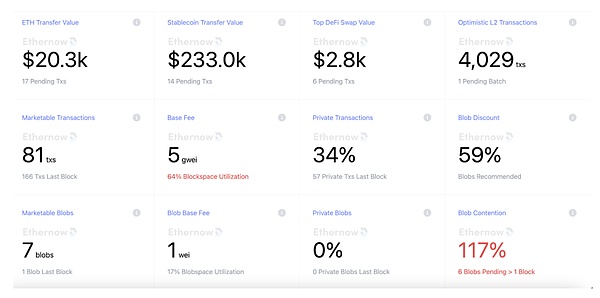
Source: Ethernow
Let’s calculate the cost of two blob transmissions as an example:
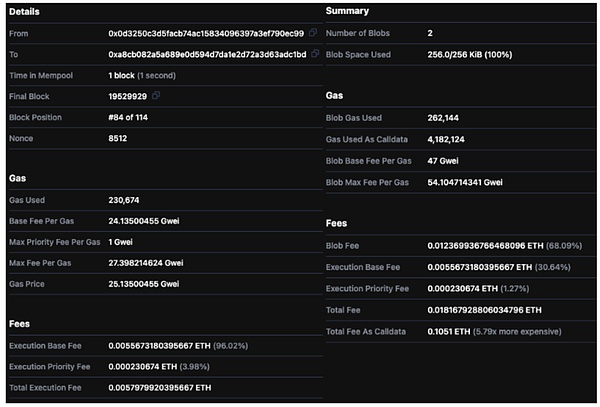
Source: Ethernow
The figure shows a type 3 transaction of Zksync’s Validator Timelock in a block on March 28, 2024. We calculate its data cost based on the blob fee, execution basic fee and priority fee decomposition:

Assuming Ethereum’s price is $3600, the data cost of using 1Mib blob at that time was about:
4×0.018ETH×3600USD/ETH = 259.2USD
We will take another zksync era type 3 transaction on June 24:
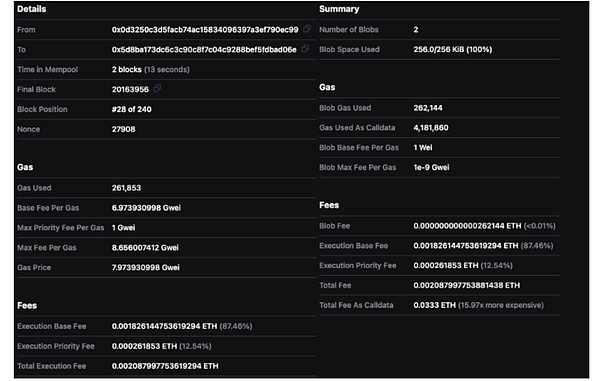
Source: Ethernow
At that time, the main network activity dropped slightly. Let’s break down and calculate its data cost:

The data cost of using 1Mib blob at that time was about:
4×0.0021ETH×3600USD/ETH = 30.24USD
This shows the uncertainty of the cost of using blobs to transmit data, and is still relatively high.However, for a rollup, the stability of the cost structure is one of the key considerations when choosing a DA solution.
2.2 Celestia
As the founder of modular blockchain, Celestia focuses on providing DA layer and consensus layer, separating the execution layer, thereby specifically optimizing DA functions and improving efficiency and scalability.Celestia, as an off-chain solution, has many different technical features compared to using the Ethereum on-chain method, which reduces the cost of data availability and provides relatively higher flexibility and scalability.The modular design makes Celestia extremely flexible, allowing developers to freely choose the execution environment, not limited to specific virtual machines (VMs), allowing Celestia to support a variety of application scenarios and meet diverse needs.
If Rollup wants to integrate Celestia as the DA layer, the transaction data (Data blob) generated by the execution layer must be submitted to the Celestia network instead of the original Layer 1 (Ethereum) to ensure data availability for verification and transactions.Celestia’s Data Availability Sampling (DAS) technology recodes block data using a two-dimensional RS erasure coding encoding scheme, allowing light nodes to verify data availability by downloading a small portion of the block data., and allows multiple nodes to process different data parts in parallel, improving overall efficiency.
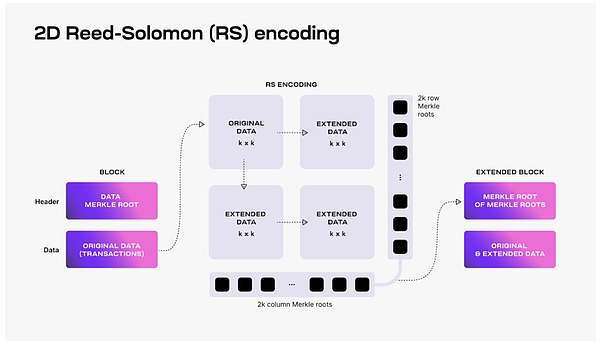
Source: Celestia.org
Another key technology in the process is the namespace Merkle Tree (NMTs) technology introduced by Celestia, which enables different rollups to download transaction data related to themselves, thereby improving data processing efficiency.NMTs not only reduce data redundancy and improve system performance, but also provide developers with more efficient data processing methods.

In terms of security, Celestia based on the Tendermint consensus mechanism, verifiers reach agreement with Data Blob to ensure the availability and consistency of data in the network and tolerate up to one-third of the validator nodes’ failures or malicious behavior.By pledging TIA tokens, Celestia’s validators are financially motivated to ensure honest behavior and confiscate malicious behavior or improper operation, thus ensuring the security of the network.Currently, Celestia’s TVL is about US$6.44 billion, and the number of full nodes is 100.
Regarding scalability, Celestia’s block size can be dynamically adjusted based on the number of active light nodes in the network.With more nodes added, Celestia can safely increase block size, theoretically increasing throughput and scalability unlimitedly.Current data shows that its data throughput is approximately 6.67 MB/s.
Celestia Blob capacity and storage features and pricing mechanism:
For cost comparison, we briefly discuss the performance of celestia and the pricing mechanism here.When a user submits data on Celestia, it is achieved by submitting a Blob Transaction (BlobTx), and the fee consists of blob space fees and gas fees.
Specifically, the maximum size limit for each blob is slightly less than 2 MiB (1,973,786 bytes), and each block can contain multiple blobs, depending on the total size limit of the block.The current maximum block size is 64×64 shares (approximately 2 MiB), with a total of 4096 shares, one of which is reserved for PFB (PayForBlobs) transactions, and the remaining 4095 shares are used for data storage.Celestia’s fee market is similar to Ethereum’s EIP-1559 mechanism, using a priority memory pool based on gas prices.Transactions with higher transaction fees are preferred by validators, and the fees are composed of fixed fees per transaction and variable fees based on each blob size.
According to the comprehensive statistics of rollup data on celenium (June 17), for each customer who integrates Celestia, the cost of using Celestia’s DA is between 0.02-0.25 Tia/Mib, which is equivalent to the price of $TIA on June 17 ($7.26), the DA costs for several major customers range from $0.15 to $1.82/MiB.Therefore, compared with native DA on the Ethereum chain, Celestia provides a competitive and stable cost structure.

Source: Celenium
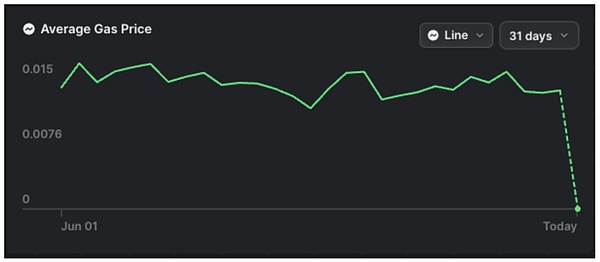
Source: Celenium, gas price is stable at around 0.015UTIA (1 uTIA = TIA × 10 − 6)
However, Celestia itself is a Layer1 blockchain network, and requires P2P network to broadcast and agree on Data Blobs. Although light nodes can use DAS to ensure data availability, the network still has high requirements for its full nodes (128 MB/sDownload and 12.5 MB/s upload), bringing obstacles to decentralization and future throughput improvements.In contrast, EigenDA adopts a different architecture—no consensus is required, nor does it require P2P networks.
2.3 EigenDA
As an active verification service (AVS) built using EigenLayer, EigenDA takes advantage of Ethereum’s security through restaking mechanism (no need to introduce a new set of validators, Ethereum validators can freely choose to join, and EgenDA’s restaking node is EtherThe subset of the nodes) to ensure data availability and make good use of existing infrastructure directly.The main workflow is that the Rollup sequencer generates Blob Data and sends it to the Disperser (can be run by the rollup itself, or through a third party, such as EigenLabs). The Disperser will shard the Blob Data, generate erasure codes and KZG promises.Then publish to EigenDA’s node, and then EigenDA’s node will verify the Attestation and ensure data availability. After the verification is completed, the node needs to store the data and send the digital signature back to Disperser.Finally, Disperser talks about collecting signatures and uploading them to the EigenDA smart contract on the Ethereum main network for the correctness verification of the final aggregate signature.
The core idea is still to use technology to reduce the requirements for node data storage and verification computing power.However, EigenDA chose KZG promise verification technology consistent with the Ethereum upgrade to implement it.Furthermore, EigenDA does not rely on consensus protocols and P2P propagation, but uses unicast to further increase consensus speed.
And to ensure that the EigenDA nodes really store data available, EigenDA uses the Proof of Custody method. If it occurs, anyone can submit a proof of proof to the EigenDA smart contract, which will be verified by the smart contract.If the verification is successful, the lazy validator will be slashed.
Therefore, EigenDA’s solution process is carried out on Ethereum, and the consensus guarantee is provided by Ethereum. Therefore, it does not have to be limited to the bottlenecks of consensus protocols and low throughput of P2P networks. No nodes need to wait for order sorting, and can directly process data availability in parallel.It proves that network efficiency has been greatly improved.

Source: Eigenlayer
EigenDA capacity performance and cost:
EigenDA currently has 266 node operators.Its maximum throughput target is 10Mbps.According to the 7-day average data, EigenDA’s data throughput is 0.685Mib/s, and the data storage and transmission fee is about 0.001Gas/Byte. In comparison, assuming that the gas fee is 10gwei and the Ethereum price is $3600, the fee per 1MB of data is about 1MB.It’s $0.038.The total pledged TVL is 3.33M ETH, close to US$1.2 billion.

Source: EigenDA.xyz
Comprehensive Comparative Analysis Celestia vs. EigenDA
From a technical point of view, Celestia and EigenDA differ in several ways.First of all, in terms of node load, the full node of Celestia needs to handle broadcasting, consensus and verification. The download bandwidth requirement is 128MB/s and the upload bandwidth requirement is 12.5MB/s. The node of EigenDA does not handle broadcasting and consensus, and the bandwidth requirement is only0.3MB/s, and it can use a subset of Ethereum nodes.Secondly, in terms of throughput, Celestia’s maximum throughput is about 6.67MB/s, while the EigenDA target reaches a maximum of 10MB/s.In terms of security, Celestia’s security comes from its network value, with a pledge value of approximately $6.65 billion and an attack cost of more than $4 billion.EigenDA inherits part of Ethereum’s security based on the re-staked asset value and mainnet operator share. Currently, TVL is close to US$1.2 billion, which inherits approximately 2% of Ethereum’s security.
Overall, Celestia’s competitive advantage lies in its flexible modular design and high data throughput, making it more popular among small and medium-sized L2 and application chains.EigenDA’s advantage adopts the orthodoxy brought about by using Ethereum infrastructure, decoupling data availability from consensus.In the future, with the development of the dual trends of modularization and application chain, Celestia may benefit from the incremental market, while EigenDA may occupy a larger share in the Ethereum center market that requires higher security.
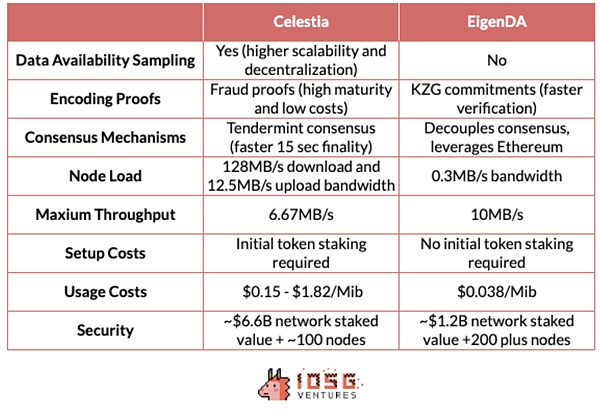
3. Avail and NearDA
Although Celestia and EigenDA currently dominate the data availability market, the competitive landscape may change in the future.With the potential launch of the two projects, Avail and NearDA, the competitive situation in the data availability field is expected to intensify further.
Avail is a blockchain network focused on data availability, aiming to provide efficient transaction sorting and data storage services for EVM-compatible blockchains and Rollups.It adopts the BABE and GRANDPA consensus mechanism inherited from the Polkadot SDK, Avail uses KZG polynomial commitment as proof of validity, supports up to 1,000 validators using nominated proof of stake (NPoS), and is provided through a unique light client P2P network sampling mechanismReliable backup.
On the other hand, NearDA is a data availability solution launched by NEAR Foundation, which mainly provides DA services to ETH Rollup and Ethereum developers.Its goal is to provide a cost-effective DA solution with a decentralization level comparable to Near Protocol.Currently, strategic partnerships have been established with major players in the Ethereum ecosystem such as Polygon CDK, Arbitrum, and Optimism.
In the short term, for Rollups, more effective reduction of marginal costs is the best way to establish barriers, among which adjusting revenue and cost models to market conditions is a better solution.
4. DA for specific scenarios
In addition to the above-mentioned universal DA for rollup, some early DA projects have emerged in the current DA track, such as Zerogravity (0G), a high-throughput DA solution customized for AI, and bits.Coin DA solution Nubit.
4.1 Zerogravity (0G)
AI applications have different requirements for data availability than traditional blockchain applications.AI model training and operation requires processing a large amount of data, including model parameters, training data sets, real-time data requests, etc.This data needs to be stored and transferred quickly and reliably to ensure the efficiency and performance of the AI model.However, existing general DA solutions, such as Celestia and EigenDA, are mainly designed to meet the data availability needs of ordinary blockchain applications, and have certain limitations when dealing with large-scale data transmissions with ultra-high throughput and low latency.
ZeroGravity (0G) hopes to specifically meet the needs of AI applications through modular design and high-performance data transmission.Its modular design divides the data availability workflow into two channels: data release and data storage, so that the system can scale linearly with the increase in the number of nodes.The data storage channel focuses on big data transmission, ensuring that big data can be stored and accessed almost instantaneously.The data publishing channel is used to ensure the availability of data and is verified through an arbitration system based on most honest assumptions.0G Storage is an on-chain database composed of a network of storage nodes.Storage nodes participate in the “Proof of Random Access” (PoRA) mining process to ensure data availability and integrity.It supports storing various types of AI-related data, including model, training data, user requests, and real-time retrieval enhanced generation (RAG) data.
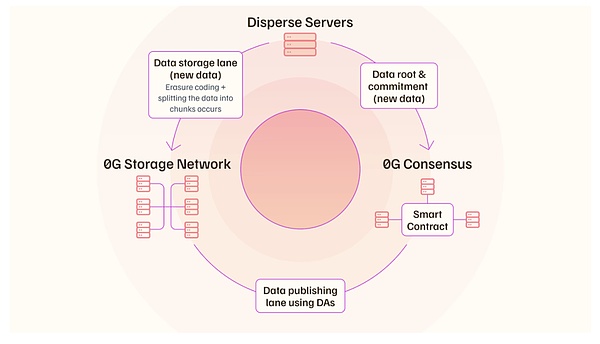
Source: 0G
0G claims its goal is to achieve GB-per-second on-chain data transmission, far exceeding other DA solutions on the market today (such as MB-per-second data transmission for Celestia and EigenDA).Specifically, 0G claims that its data throughput can reach 50 to 100 GB per second, and can support scenarios such as AI model training that requires a large amount of data transmission.
4.2 Nubit
As the Bitcoin ecosystem gradually started and attracted attention, various technical routes about Bitcoin have also been in turmoil. With the development of these technical routes, the demand for efficient and secure data availability solutions for applications such as Ordinals, Layer 2, oracleIt is also becoming more and more urgent.These applications need to be able to store and transfer large amounts of data quickly and reliably to ensure their proper operation and user experience improvements.For example, Ordinals requires efficient data storage and transmission to support the creation and transaction of digital artworks, Layer 2 solutions require high throughput and low latency for better scalability, and oracles require reliable data transmission to ensure dataaccuracy and timeliness.
Nubit is the first native data availability (DA) layer project in the Bitcoin ecosystem, aiming to solve the problem of limited throughput of Bitcoin main network and provide infrastructure support for the long-term development of the Bitcoin ecosystem.Nubit’s workflow includes multiple steps such as data submission, verification, broadcast, storage, sampling, and consensus, ensuring efficient processing and high availability of data.After the user-submitted data is RS-encoded, the verifier node uses the NuBFT consensus algorithm to verify it and generates a KZG commitment.The verified data block is broadcast to the entire network, and the storage node is responsible for storing the complete data block, while the light client verifies the availability of data through the Data Availability Sampling (DAS) protocol.Even in the event of a network failure, nodes can recover data through full storage nodes and KZG on the Bitcoin network.
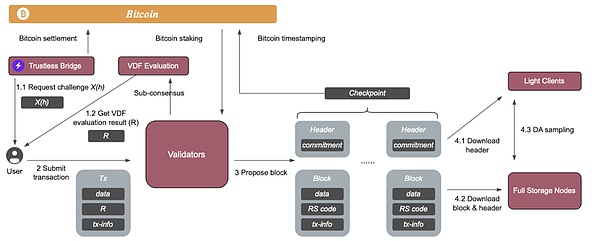
Nubit aims to provide infrastructure for Bitcoin ecological projects and has established partnerships with multiple projects such as Babylon, Merlin Chain, Polyhedra, etc. Nubit will reduce data storage costs. For example, in the case of the surge in demand for the inscription market, Nubit can serve.With Bitcoin Layer2, it significantly reduces the cost of data release, making storing and processing data on Bitcoin more economical.
5. Close Thoughts
Analyzing project differences in DA tracks, we are in security (including data integrity, network consensus, etc.), customizability and interoperability, performance and cost. With the widespread adoption of these DA solutions and different projects in the DA layer selectionWe see a series of unique technologies and market positioning.
In the future, we believe that more App-Rollups will be launched on the market.However, although the potential market has increased, the head effect of the DA track is obvious, and Celestia, EigenDA, etc. will occupy the main market share, leaving few opportunities for the waist and tail, and competition is intensifying.Current capacity is oversupply for Rollup. For example, after launching the main network, the utilization rate of Celestia network bandwidth is below 0.1% for a long time, which is much lower than its maximum support capacity of 46,080 MB per day.However, compared with Ethereum’s current 15 Rollups and 700 MB of data per day, Celestia still has a lot of room for activity.
Of course, it is not ruled out that there may be high-performance networks in the future for high-DA bandwidth, or for example, AI projects. In addition, there are some relatively early DAs and specific scenarios, such as Bitcoin DA, which may be good in the subdivided fields.market share.But DA is essentially a to B business, and the revenue of DA project parties is closely related to the quantity and quality of ecological projects.At this stage we don’t think there is too many off-chain DA solutions needed in the market unless their cost and efficiency make several orders of magnitude leaps.
In general, DA’s business model is now in sufficient supply, but the development of the track is still evolving, and various solutions show different competitiveness in technology and market positioning.Future development will depend on continuous innovation in technology and dynamic changes in market demand.


